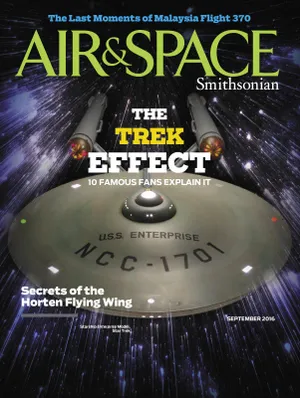Starship Enterprise: The Extended Mission
A half-century after its television debut, notable space and entertainment figures explore the impact of Star Trek.
:focal(2428x1424:2429x1425)/https://tf-cmsv2-smithsonianmag-media.s3.amazonaws.com/filer/96/f0/96f07b02-d10d-415a-8e1b-df76284d2511/04p_sep2016_enterprise-2_1894_live.jpg)
“The Man Trap” was not the first episode of Star Trek to be produced, but it was the one NBC chose to air first, on the evening of September 8, 1966. The plot involved the last of a race of shape-shifters, one that kills crew members of the starship Enterprise because it needs the salt in their bodies to survive. At the end of the episode, a creature that has variously taken the form of an attractive woman or man—whatever form each of its victims finds most alluring—is revealed as a bizarre-looking monster. NBC considered that element quite salable—a nod to the creature-features more familiar to viewers than the kind of high-minded, unsubtly allegorical science fiction for which Star Trek would become famous. Eighteen months earlier, the network had rejected “The Cage,” Star Trek’s first pilot, as too cerebral, but taken the then-unprecedented step of commissioning a second pilot.
Over the course of the series’ three seasons, NBC and Star Trek creator Gene Roddenberry would clash frequently. The show never got the kind of ratings that might have inclined executives to overlook its habit of riling censors and sounding off on topics like the Vietnam War and race relations. Only in syndicated reruns did Star Trek become a sensation, paving the way for a series of feature films that began with Star Trek: The Motion Picture in 1979 and spinoff TV series starting with Star Trek: The Next Generation in 1987. (Star Trek Beyond, the 13th movie in the franchise, opened in July, while the seventh small-screen series, Star Trek: Discovery, will premiere in January 2017.) Made in a tumultuous era of American history, Star Trek’s promise that by the 23rd century, humankind will be but one of many peace-loving races in a space-faring United Federation of Planets had a profound influence on at least two generations of explorers and innovators. The show’s importance in popular culture has won the original studio model of the Enterprise a prominent place in the Boeing Milestones of Flight Hall at the National Air and Space Museum.
Fred C. Durant, a former rocket engineer and U.S. Navy test pilot who served as an assistant director at the Museum until 1980, corresponded with Roddenberry throughout the 1970s. Durant pointed out that rocket pioneers Konstantin Tsiolkovsky, Robert H. Goddard, and Hermann Oberth all acknowledged the 19th century science fiction author Jules Verne as an influence on their work. “The Star Trek series represents the same kind of invitation to imaginative thinking,” Durant wrote in a 1975 letter.
To prove it, Air & Space asked a panel of scientists, astronauts, and influencers what it is that has made Star Trek live long...and prosper.
Phil Plait
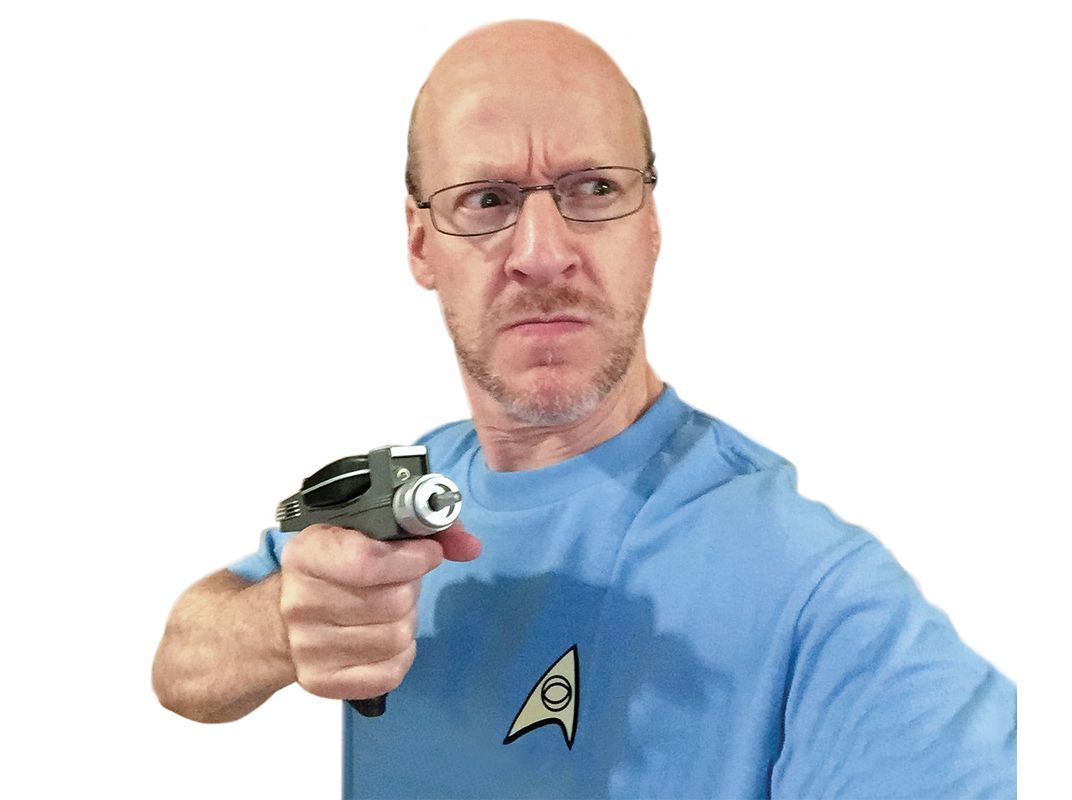
“The Bad Astronomer.” Author, Bad Astronomy and Death from the Skies. Slate columnist.
Favorite Star Trek story: Star Trek II: The Wrath of Khan (1982). Not even close.
Favorite character: The starship Enterprise. You may argue it wasn’t a character; but if not, why did almost every single episode end with a shot of it moving on to the next adventure? Seeing the original Enterprise, fully restored and in gorgeous shape, at the National Air and Space Museum was truly lovely.
Fondest memory: When I was a kid, sci-fi movies and TV shows were about humans beating (or being beaten by) monsters. The Original Series episode “Devil in the Dark” showed that who was the monster isn’t always that clear-cut, and that had a deep effect on me.
Trek tech I wish were real: I want one of the projectors from the Astrometrics Lab seen in Star Trek: Generations (1994).
Something Trek got wrong: I’m willing to forgive a lot of scientific transgressions, but when distances are messed up it bugs me. At warp 9, the Enterprise could cover the distance from Mercury to the sun in a tiny fraction of second, but in [1986’s Star Trek IV: The Voyage Home], it still took quite some time. Things like that of course aren’t a huge deal, but they distract me and make it harder to suspend my disbelief. [Editors’ note: While explanations of Warp technology have been refined over time, generally speaking, Warp 1 is roughly the speed of light, and each Warp factor represents an exponential increase. Warp 2 is four times light speed; Warp 9 would be 729 times the speed of light.]
Terry Virts
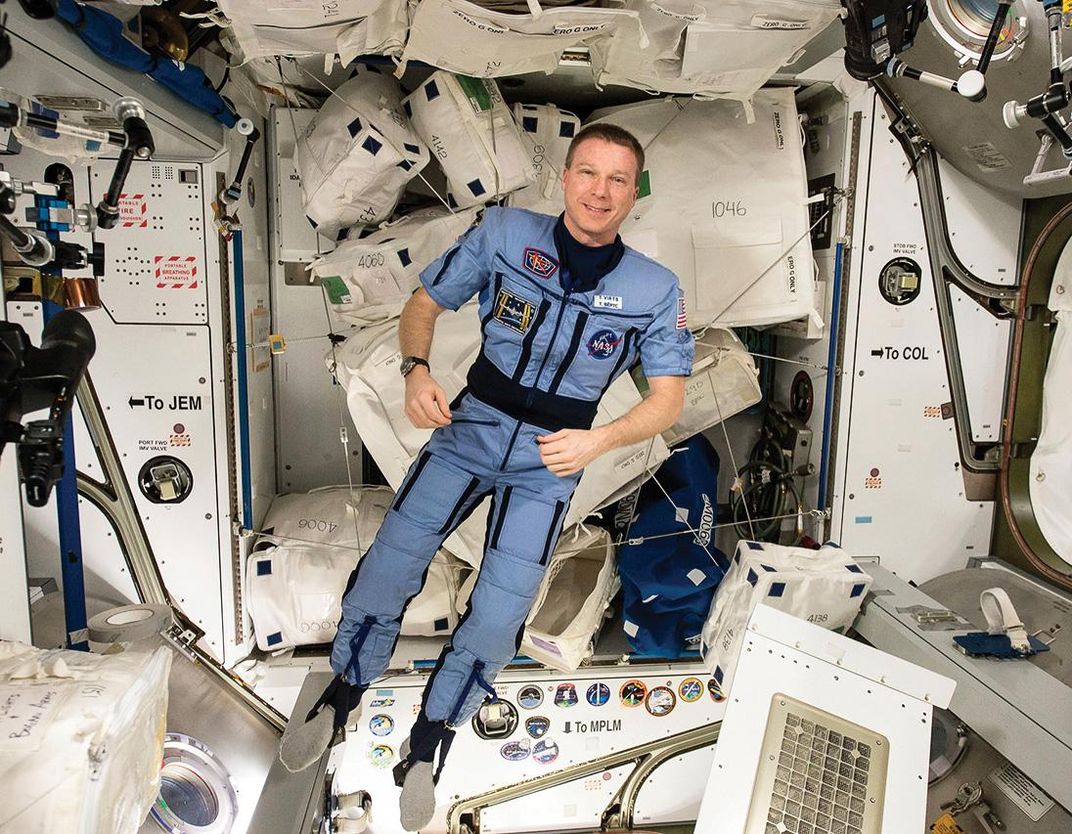
U.S. Air Force colonel; NASA astronaut, pilot of space shuttle mission STS-130. F-16 pilot with more than 4,300 flight hours in more than 40 types of aircraft.
Favorite character: Captain Kirk, of course. The original. What else can I say?
Fondest memory: I remember going to see that first Star Trek movie with my dad in the theater and being excited to see what they might have dreamed up as the storyline or new technology. It came out before I was even a teenager, and I was just completely excited about space and science fiction at the time.
Lesson or inspiration: We actually studied leadership via Star Trek at the Air Force Academy. There were a lot of practical lessons to learn about decisiveness versus being too rash, or performing your specific role well to help the team. It was an interesting study in real-world leadership through this fictional show.
Trek tech: The machine that makes food automatically [the Replicator] would be pretty cool, but of course you cannot beat the Transporter. Interestingly enough, the communicator has become real.
Something Trek got wrong: When you’re out in space you float; you cannot walk around like you were on Earth when you’re in orbit or traveling between planets. But it makes the production costs a lot cheaper not to have to visualize weightlessness on the big screen. [Editors’ note: Vessels in Star Trek are equipped with artificial gravity. In 1991’s Star Trek VI: The Undiscovered Country, we see the inside of a Klingon vessel after its gravity device has been damaged, and the crew members are floating. Indeed, this visual effect would have been beyond the resources of the TV show 25 years earlier.]
Samantha Cristoforetti
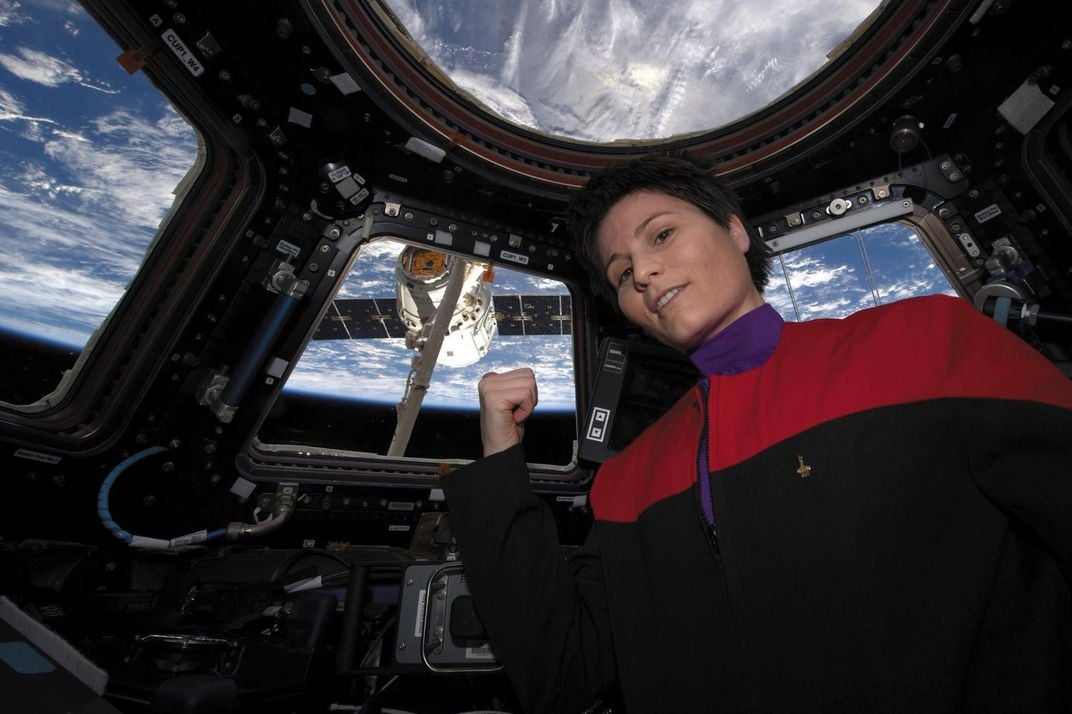
Italian air force captain, European Space Agency astronaut. Crew member, International Space Station expedition 42 and 43. 199 continuous days in space.
Favorite story: Star Trek II: The Wrath of Khan.
Favorite character: Jadzia Dax. [Editors’ note: Jadzia Dax is a symbiotic being from the 1993–1999 series Star Trek: Deep Space Nine. She bears Jadzia’s humanoid appearance, but her consciousness is shared with Dax, a benevolent 300-year-old creature who lives inside her body, giving her access to the skills and memories of Dax’s previous hosts.]
Fondest memory: Watching overnight Star Trek marathons in college.
Trek tech: Definitely the Warp Drive.
Something Trek got wrong: Too many species looking too much like humans (probably due to the limitations of makeup and special effects).
James B. Garvin
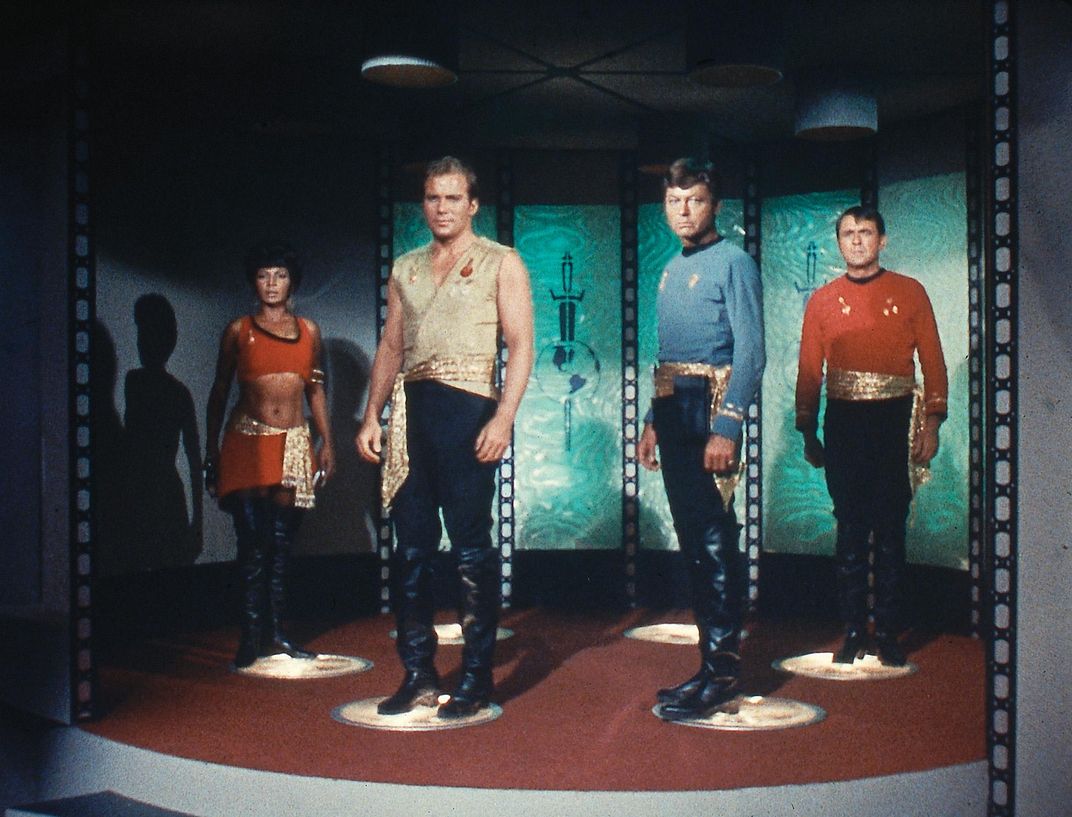
Chief Scientist, NASA Goddard Space Flight Center. Recipient of two NASA Outstanding Leadership medals for his work on the Mars Exploration Program.
Favorite story: I adored most of the episodes of Star Trek: The Next Generation (1987–1994) and Star Trek: Voyager (1995–2001). The Original Series was fantastic, but I was too young when it aired to be as moved as I was by the later series.
My single favorite is the Voyager episode “One Small Step,” about a doomed 21st century human mission to Mars and how that mission’s loss became a catalyst for the Voyager’s creation. This connected to me personally since I have been working on Mars exploration for my entire career, more than 30 years.
This episode highlighted how past failures open the door to future successes. This is what happened in our Robotic Mars Program when we lost two of our missions, the Mars Polar Lander and the Mars Climate Orbiter, both in 1999. After that, we went on to build our present Mars program with the Curiosity rover, Mars Reconnaissance Orbiter, and the Mars 2020 Rover.
Fondest memory: Watching the entire Voyager series with my children one summer. We found a low-cost DVD set and went through the whole thing over the course of about two months. My kids were both teenagers at the time. I loved seeing how they reacted to the wonders of Star Trek as an idea, melding what science and engineering in the future might bring with the hopeful, optimistic spirit of human-based exploration.
Something Trek got wrong: To me, the miracle is how much it got right, not the science inconsistencies or other factors that some colleagues lament. But I’ll name two things Star Trek might have done better.
(1) How human interaction with IT is presented. When [the Original Series] was conceived, creating a cyberspace future that goes vastly beyond today’s capabilities would’ve been impossible, but I do believe the way people and computers (if we’re even still calling them that in a few hundred years) interact is oversimplified. Will we still be talking to computers via tablets or voice commands? Perhaps Lieutenant Commander Data [the android officer from The Next Generation] or the Emergency Hologram Doctor [from Voyager] are better projections of how we will engage with IT.
(2) Situational awareness on a starship via a large window-like view screen. I can imagine a more futuristic projection of how the crew would “see” where the ship is going and what is happening.
Justin Lin
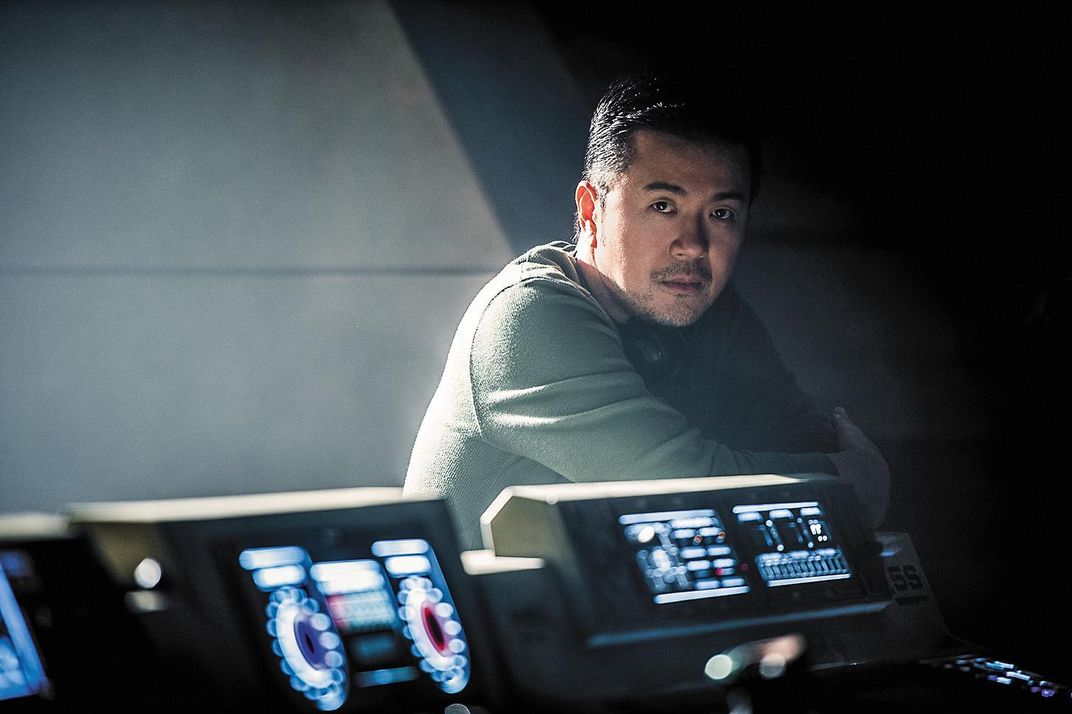
Filmmaker. Director, Star Trek Beyond, as well as installments 3 to 6 in The Fast & the Furious franchise.
Favorite character: [USS Enterprise physician Leonard “Bones”] McCoy, hands down. I just love his dry humor, and the curmudgeon aspect of McCoy. He was always my favorite.
Fondest memory: I was eight years old the first time I saw [the Original Series]. I didn’t realize they were reruns for a long time! It took me a while to figure out that it wasn’t a new show every night. We had just moved to the States from Taiwan. Watching those old episodes was kind of the only time I got to spend with my parents.
Lesson or inspiration: To see this crew on this exploratory journey together really redefined for me the idea of family. That it could be a crew. Family isn’t just by blood. I didn’t realize it until this movie, but the family aspect of my Fast films—I think that’s from the mark Star Trek left on me as a kid.
Trek tech: I always thought the beaming was the coolest. We have a scene in Star Trek Beyond in the Transporter bay, and as soon as I walked onto that set all these memories from my childhood just hit me. So I’m going with the Transporter Beam.
Simon Pegg
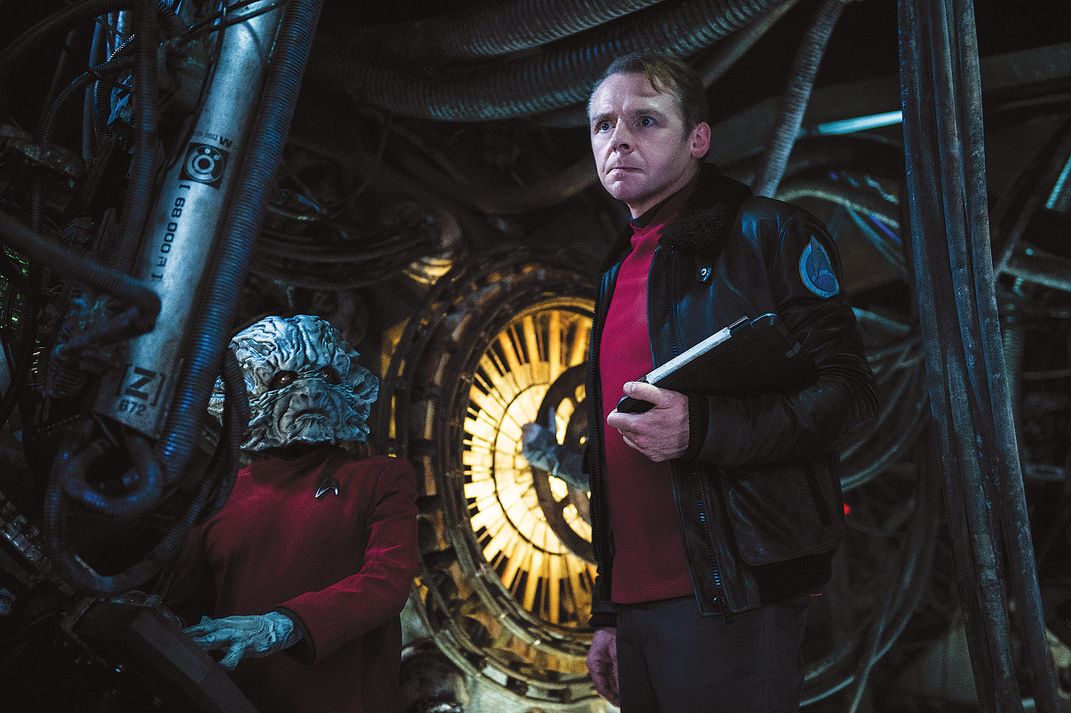
Co-screenwriter, Star Trek Beyond. Played Enterprise Chief Engineer Montgomery “Scotty” Scott in three films, beginning with the 2009 reboot Star Trek.
Favorite story: I always come back to “The Corbomite Maneuver,” one of the earliest episodes from the first season. It had Clint Howard as this strange little boy who had this sort of alien proxy that he would use to intimidate ships, a character called Balok. As a child he terrified me, because his visage was featured in the photo montage under the closing credits. It’s just a great episode, one of those classic chess matches between Kirk and the crew and their adversary.
Favorite character: Scotty aside, I’d probably say Spock. I love that he’s almost like this stern father figure who you constantly look to for emotion, and they don’t often give it, but when they do, it’s absolutely delightful. In episodes like “Amok Time” or “Shore Leave,” where Spock would drop his Vulcan discipline and bits of his humanity would creep out, that was always so welcome and so fun. He was this cypher, who somehow managed to suppress his human emotions, but whenever they crept out you were just so pleased to see he was actually a good guy.
Trek tech: So much of it is coming to pass. The Universal Translator is almost with us; you can get real-time translation on your iPhone. So it’s got to be the big ones left to discover. Warp drive, so we could get out into the galaxy. I don’t know if there’s intelligent life out there. We might just be an abomination. I expect there are other planets with life on them, but the odds of them being at the same evolutionary stage as us are infinitesimal.
Carolyn Porco
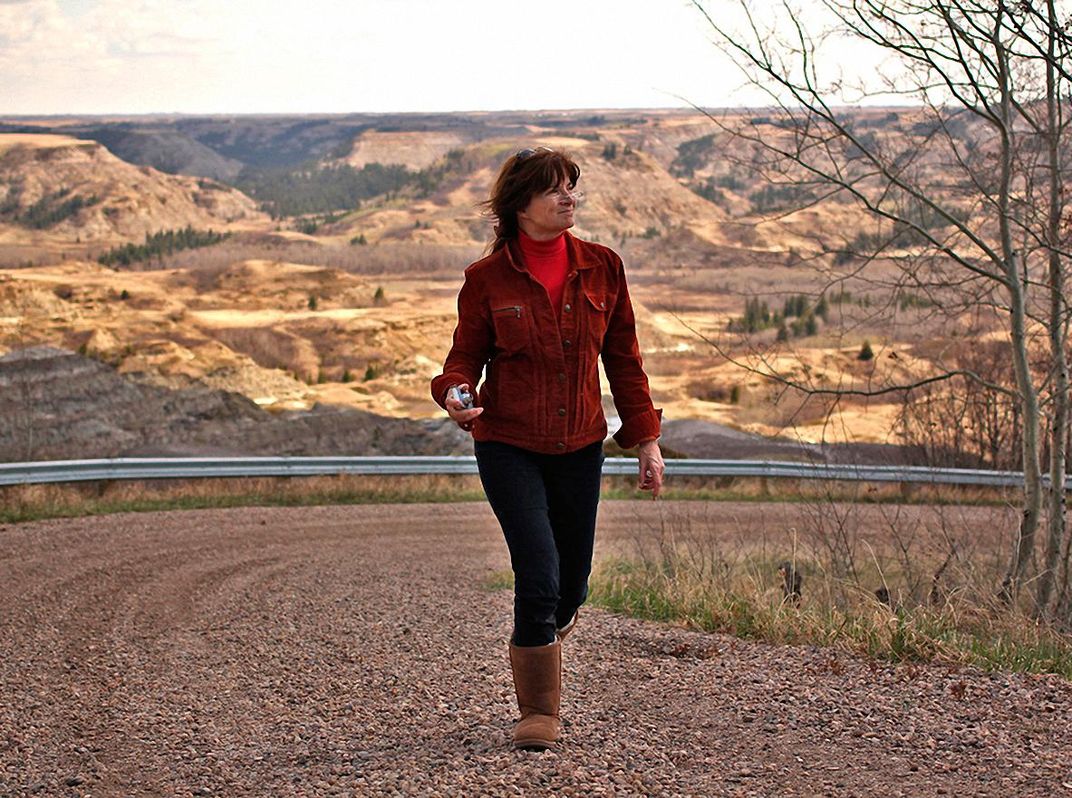
Planetary scientist. Director, Mission Operations, Cassini Imaging Team. Member, Voyager Imaging Team. Saturn expert. 2010 recipient, the American Astronomical Society’s Carl Sagan Award. One of Time magazine’s 25 Most influential People in Space, 2012.
Favorite story: The Motion Picture, where the Voyager spacecraft is the mystery guest star. And The Wrath of Khan, with the Genesis planet.
Favorite character: Spock, of course. And Kirk. And [Star Trek: The Next Generation’s Enterprise-D captain] Jean-Luc Picard.
Lesson or inspiration: Star Trek presented to us a Utopian vision of ourselves, wedded to the enduring saga of good versus evil, writ cosmically large across the galaxy and into the future, and played out by a cast of beloved characters.
It gave a comforting assurance that humanity has what it takes to become an interstellar civilization, that we do indeed have a future beyond Earth.
Trek object you wish were real: The Transporter Beam, without a doubt!
Eugene “Rod” Roddenberry Jr.
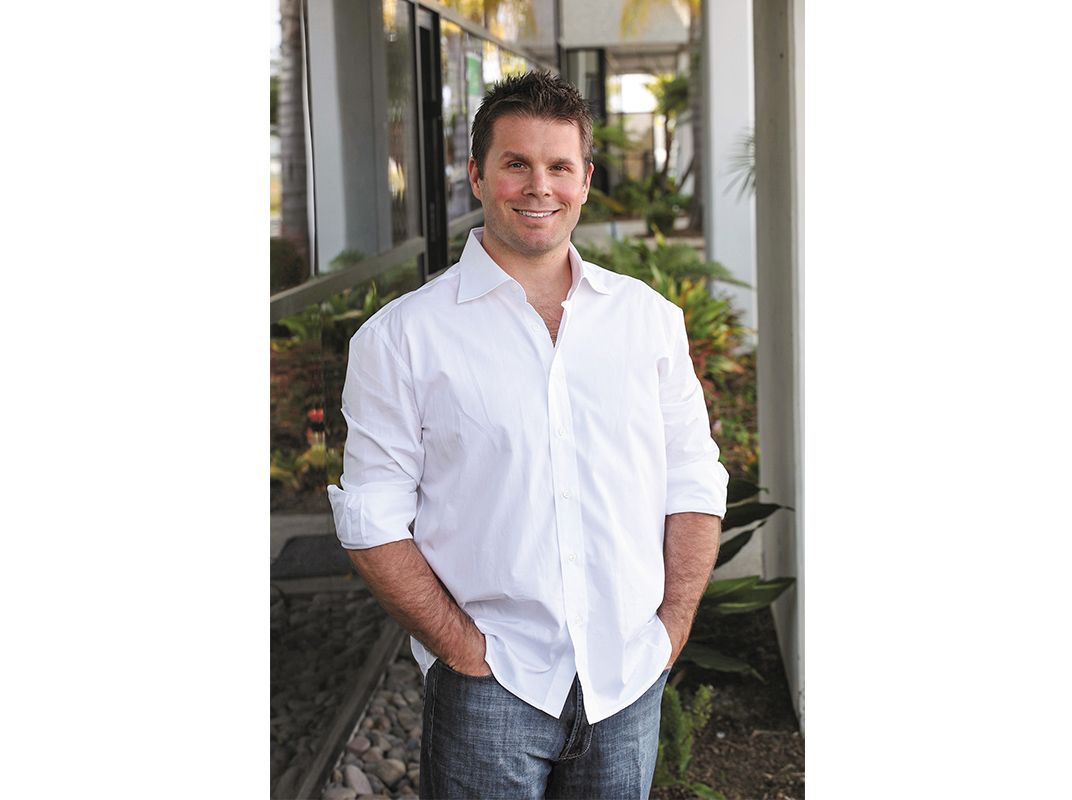
President, The Roddenberry Foundation. Executive Producer, Star Trek: Discovery (CBS All Access, 2017).
Favorite story: The Next Generation is my favorite series, but the one I’ll choose is The Original Series episode “Devil in the Dark.” My idea of television up to that point was fairly one-dimensional: There was a good guy and a bad guy, and the good guy wins in the end. In that one, you had this rock monster—the Horta—where we’re killing its young by mining its eggs. I love that they communicate with it rather than just trying to kill it. I didn’t know television could do that. I love it when there’s depth and complexity to the bad guy.
Favorite character: Lieutenant Commander Data, would be the short answer. But Spock, Hologram Doctor, [liberated Borg drone] Seven of Nine. All the alien characters that make us look back at our humanity. The Roddenberry characters, I like to call them.
Fondest Memory: When I was six or seven, my father had his old 16-millimeter projector in his home office. And he would play the blooper reel for me. I would just sit on the floor and laugh, because it was all people falling down or running into doors. I didn’t yet know what Star Trek was, but that’s my earliest vivid memory of it.
Trek tech: The replicator. The minute we can control the atom and replicate anything we want—including the replicator, so everyone has access to a replicator—money loses all value. What then becomes valuable is the individual. The idea. The point of view. The differences that we all share. It wouldn’t solve every problem, but the hope is that everyone has access to food and what they need to take care of their family, there will be less need—depending on whether religion gets involved or not—to create chaos.
Something Star Trek got wrong: Homosexuality. Star Trek never hit that head on, and in the ’60s, there’s no way that would’ve happened. Even in the ’80s and ’90s, the studio would not have let it be addressed directly, though they did skirt around it in some Deep Space Nine episodes. [Star Trek: Deep Space Nine aired from 1993 to 1999.] So the LGBT community asked the question, and my father’s response to it—which was sort of a sidestep, but a beautiful one—was that in the 23rd and 24th centuries, sexual orientation is just a non-issue. It’s not something that even needs to be discussed. So he didn’t need to have a rainbow flag, or some stereotypical representation of gayness, to show that. There were many gay crew members aboard the Enterprise, is what my father said.
Edward Michael Fincke
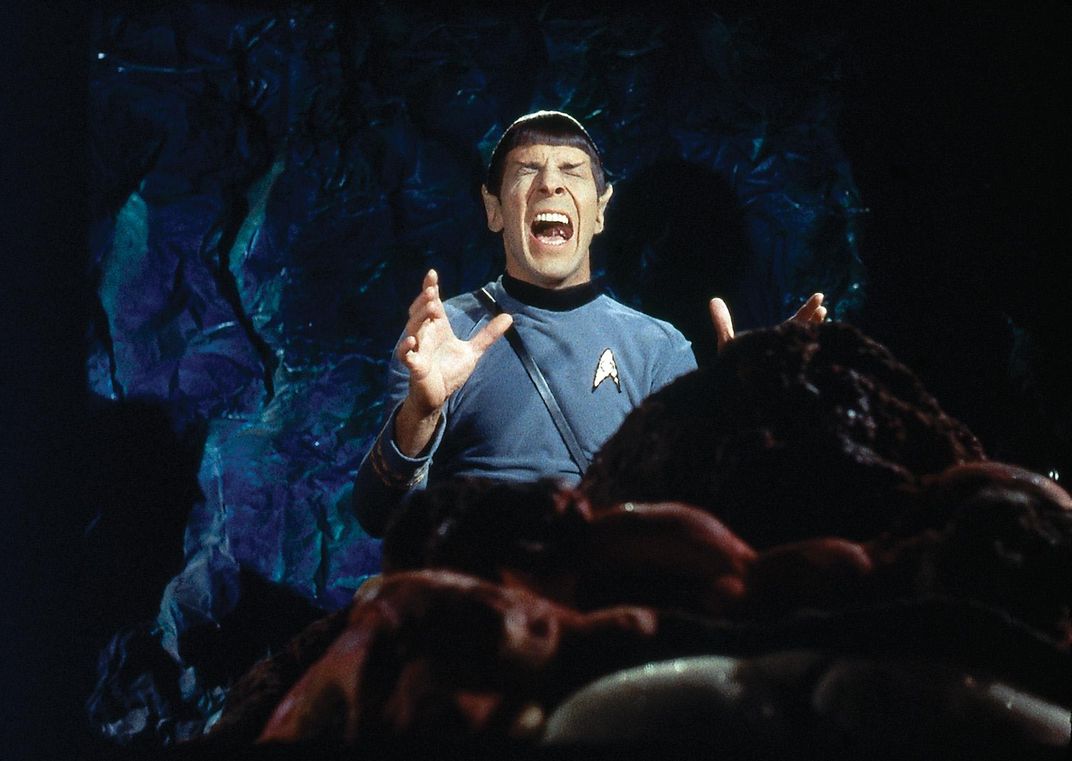
U.S. Air Force colonel, NASA astronaut. Recipient of two NASA Distinguished Service medals and three Spaceflight medals. Crew member, Expedition 9 and Expedition 18. Mission specialist, STS-134. 381 days in space; nine spacewalks totaling nearly 49 hours.
Favorite character: Naturally, I am drawn to the captains for my inspiration. I really like Scott Bakula’s Captain Archer [on the prequel series Star Trek: Enterprise, which aired 2001–2005], as well as both William Shatner and Chris Pine’s versions of Captain James T. Kirk.
Fondest memory: I was invited to the set of Star Trek: Enterprise by Scott Bakula. The show’s scenic art supervisor, Michael Okuda, showed fellow astronaut Terry Virts and me around the set. It was amazing to see the magic of taking wood, plastic, nails, and glue to make a starship. Both Terry and I were impressed with the craft it takes to make a television show. There are many moving parts and everyone needs to be always on their A-game—just like at NASA.
Lesson or inspiration: Gene Roddenberry was an optimist and his optimism is contagious. The Original Series really impacted our national psyche by showing humanity at its finest.
When human beings work together we can accomplish miracles. We have 15 countries working together on our beautiful and magnificent International Space Station. Star Trek inspired? Yes. Humanity at its finest? Yes.
Margaret Weitekamp
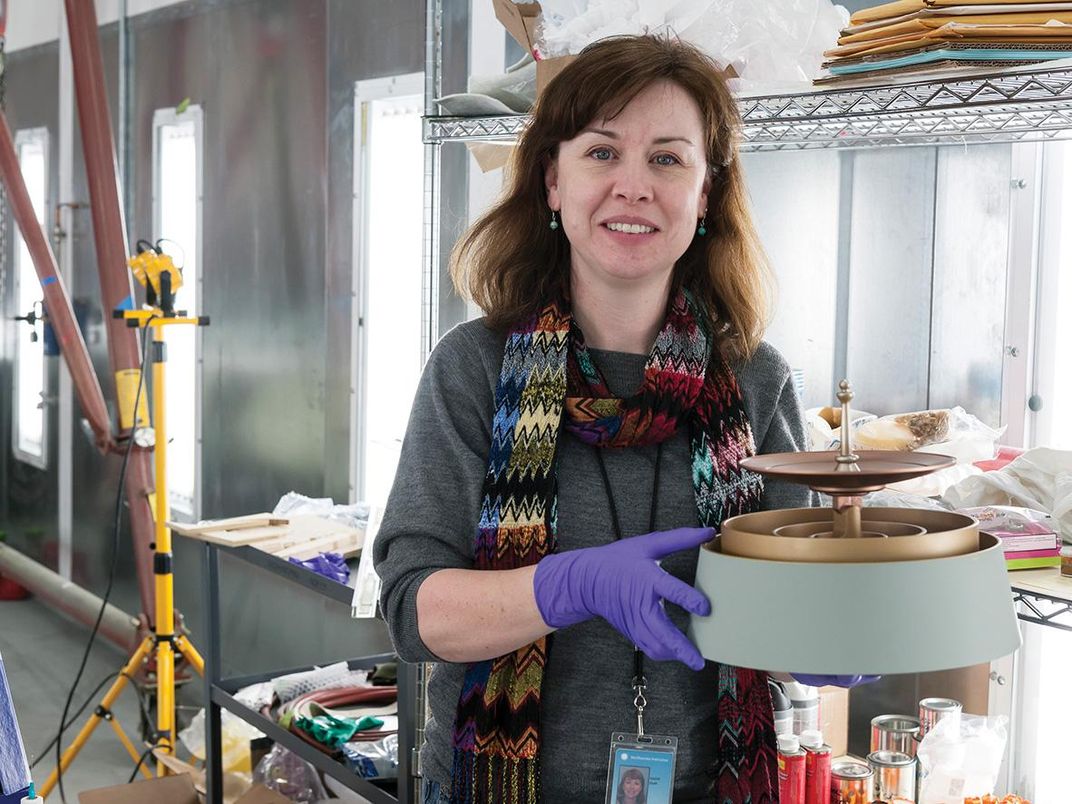
Curator, National Air and Space Museum, specializing in the social and cultural dimensions of spaceflight
Favorite story: Star Trek: First Contact (1996) because I have a soft spot for time travel stories, and we learn that the Smithsonian exhibits Dr. Zefram Cochran’s Phoenix Warp ship after its history-making flight in 2063. I should be retired by then, but maybe they’ll let an old-timer come to the donation ceremony. [Editors’ note: In the film, it is Cochran’s invention of the warp drive that persuades the Vulcans to make “First Contact” with humans, a species they had previously deemed too primitive to engage.]
Favorite character: Lieutenant Nyota Uhura, because her presence as a member of the Enterprise crew in the late 1960s resonated so powerfully as an example of men and women of different races working together. Actor Nichelle Nichols actually helped recruit astronauts for the space shuttle program in the 1970s. I was thrilled that I got to interview her for an article I wrote about the Uhura character.
Trek Tech: Transporter. I’d probably still be late to things, but it would be nice to avoid D.C. traffic.
